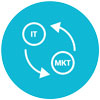Content engineering involves organizing the shape, structure and application of intelligent content.
The promise of personalized digital customer experiences can only be realized through
intelligent content that’s atomic and can be reused in multiple contexts and channels. Intelligent content is only possible through engineering.
Content engineering opens the door to a personal, cognitive, more human era. The practice of content engineering involves content modeling, schema, microdata markup, taxonomy and metadata. These disciplines help connect the dots between content strategy and development, and between marketing and IT.
Content engineering transforms old-school content management into true customer experience management (CEM). Adopting the practice gives organizations the ability to engage at every stage of the customer’s journey and relationship lifecycle.
Content engineering impacts the bottom line of an organization. It improves return on content assets. It makes CMOs, CIOs, CTOs lives’ easier and more efficient. It provides CEOs a competitive advantage with a strategic function that gives them more flexibility.
Let’s take a brief look at 9 real and tangible values of content engineering:
1. Efficient development cycles and time 
Without content engineering, software engineers spend more time on configuration and strategy than on developing software. This reduces the efficiency of highly-paid software engineers, significantly lengthens development cycles and diminishes the overall quality of CEM.
2. Better ROI on CEM investment 
Customer experience management capabilities may seem like a far-off dream compared to the current level of maturity in most organizations' marketing departments. Content engineers can help in selcting and implementing a content platform and designing and applying intelligent content strategies to ensure long-term return on customer experience campaigns and initiatives.
4. Improved sales lifecycle, performance, metrics and channels 
Content engineering improves sales by connecting buyers with the related content and products they want and need. It also allows organizations to segment content types and create detailed reports showing content engagement and how it relates to sales. Content engineering also enables multichannel publishing which expands selling channels.
5. Better customer satisfaction through personalization 
Content personalization significantly improves customer’s experience by making interactions more relevant and rewarding. It’s only through intelligent content engineering that true content personalization is possible, because only cleanly-structured content can be reused in parts and in reaction to customer session behavior.
6. Connected IT and marketing departments 
Without content engineering, content strategists and marketers find themselves with visions left unrealized, while IT teams feel frustrated with what they see as ill-defined requirements from marketing. Content engineering solves team disconnects by bridging the gap between siloed departments by giving teams a common language and tools.
7. Structured content for robots 
Robots need structured content in order to better provide answer and value to humans. Google, Siri, Cortana, Alexa, Watson and other cognitive learning systems function on the basis of understanding relationships between semantic concepts. Content engineering allows organizations to develop presence and authority by ensuring that all of their content assets can speak to and be understood by robots.
As intelligent agents become a bigger part of the way organizations understand themselves, their vendors, customers and the world around them, structured content improves an organization’s relevance in a cognitive era.
8. Atomic, reusable and adaptive content 
Engineered content assets can be used in many places at once, related, discovered and reused to deliver value at the fastest possible throughput.
Content and data assets need to be able to move seamlessly across organizational silos, web services, search tools, CRM, ERP and CEM platforms. Content must be like electricity, moving and transforming in order to power organizations. But for many organizations, content is more like a rock: chiseled and placed as a brick in some wall, never to be moved.
9. Digital maturity 
Content engineering makes organizations smarter by improving the value of content assets and connecting those assets with customers intelligently. Smarter organizations with more nimble content assets will be better prepared to compete for market position and customer mindshare. In a recent Cap Gemini study, organizations with stronger digital maturity were found to be 26% more profitable, had 9% more revenue and boosted valuations by 12%.
In short, a formal content engineering practice allows organizations to manage intelligent content assets and structure with process, discipline, accountability, centralization, standards, hygiene, security and efficiency. This is the new face of digital marketing and the path to full digital maturity.
Contact Us for a Free Consultation.